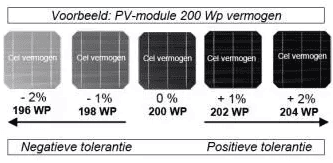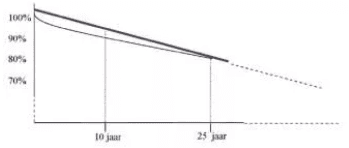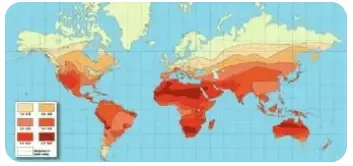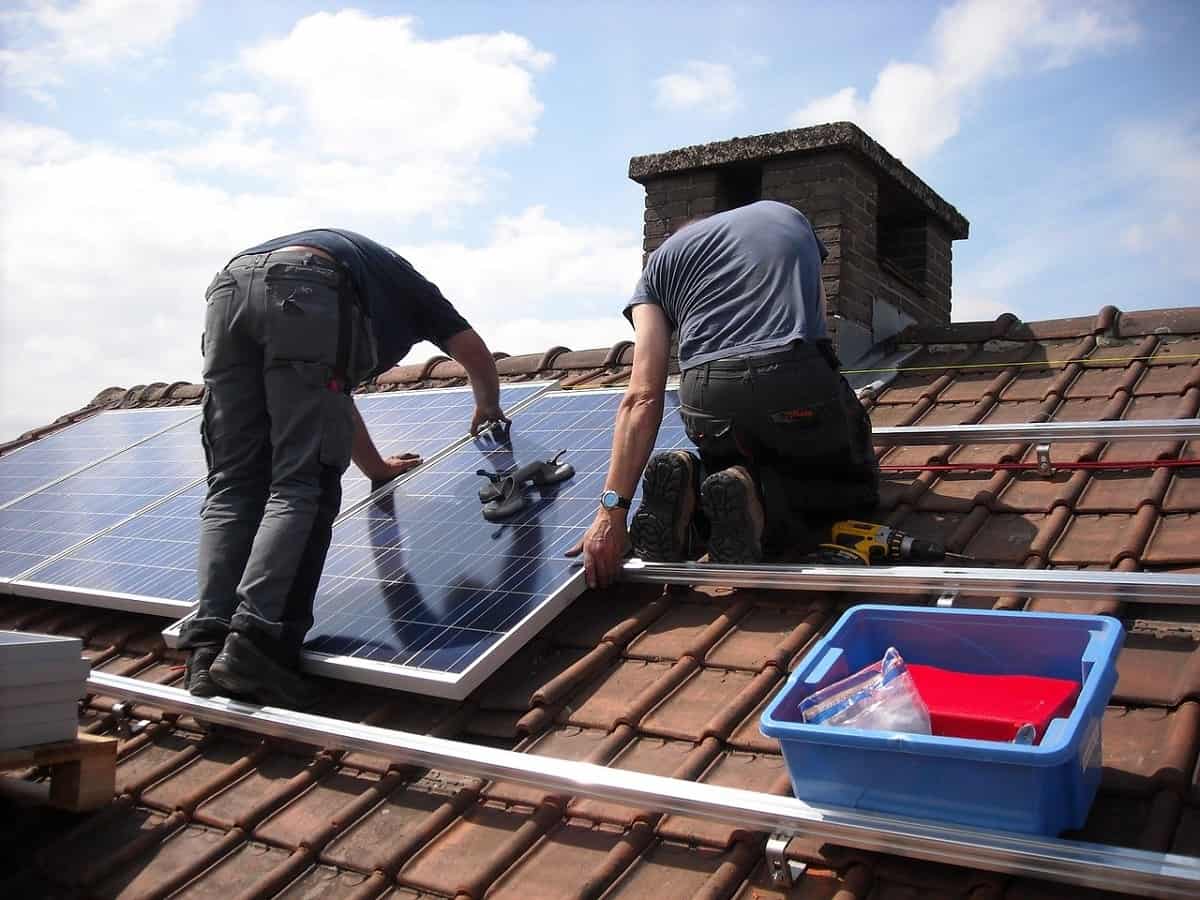Thanks to quality standards within the EU and long warranties, you can rest assured that the solar panels you buy in the Netherlands are of good quality. However, there are a number of criteria that you can pay attention to when purchasing the best solar panels. On this page we tell you what you should pay attention to and how you can recognize the best solar panels.
1. Criteria for purchasing solar panels
- The relationship between the price and the amount of energy a panel produces (in Wp, watt peak).
Often a little more energy production per panel entails a lot of extra costs. This is, for example, the case with so-called high-efficiency panels. Unless you really have a shortage of space on your roof, the additional costs are usually not worth it. - The warranty and lifespan of the entire solar panel installation.
If something breaks on a panel or production decreases, it is important that you receive proper help. The payback period for your panels is between 5 and 7 years. You want them to keep doing it for as long as possible afterward. How good your panels are is best reflected in the length of the warranty that manufacturers and installers dare to give. Usually, the longer the warranty, the higher the expected lifespan. - A good reputation of the manufacturer & installer.
A long warranty period is nice. But if the company is bankrupt after five years, that is of little use. - The quality of the installation and the supporting systems.
Consider the inverter, the mounting system, or any supporting app to measure your consumption. Also, read our article about the best solar panel installers here.
2. Poly and monocrotaline: the materials
You can choose between mono- or polycrystalline solar panels. Monocrystalline panels used to be better and more expensive.
However, due to recent technical developments, there is no longer a noticeable yield or price difference between the two types. Which panel you choose is mainly a matter of taste.
- In polycrystalline solar panels, the cells are intertwined.
- With monocrystalline solar panels, all cells face the same direction.
- Thin film panels are also available. They are cheap, but much less efficient. They are therefore rarely sold for roofs.
Nowadays, solar panels are no longer only available in blue, but also in black. The costs are then 10 to 15% higher.
All-black panels are completely black and available in both mono- and polycrystalline variants. Some people think this looks better, mainly because they are less noticeable. The dimensions of most panels are approximately 1 x 1.65 meters.
3. Highest efficiency solar panels
In addition to ‘normal’ solar panels, there are high-efficiency panels. These are usually a lot more expensive.
In general, the percentage increase does not outweigh the higher additional costs per panel. These panels are only a sensible choice when there is a lack of space, as it is the only way to obtain enough energy.
But in most cases, normal panels are a lot cheaper. It is almost never profitable to try to generate extra energy and return the excess production.
That is why it is better to take the number of solar panels you need for your own energy needs.
At the time of writing, SunPower solar panels with a capacity of 400 Watt peak per panel are the panels with the highest efficiency.
With an efficiency of 22.8%, this panel also has the highest power. When it comes to high-efficiency panels, two terms are often used interchangeably:
- High efficiency – The sunlight that a solar panel captures and actually converts into usable power. On average this is between 15 and 22%.
- High power – The higher the power of a panel, the more electricity it can generate annually.
4. Power of solar panels
Better production quality often results in a higher yield and therefore more KWh of electricity per year. In other words: higher power. The following 3 factors determine the difference in yield:
Power tolerance of solar panels
This is the tolerance that a manufacturer uses when manufacturing a PV panel.

The photovoltaic cells are tested after production and selected for placement in a panel. The better module suppliers choose to only use cells with a positive deviation. For example, a negative tolerance ensures that a panel with a power of 200Wp actually only delivers 196Wp. Such a panel included in a PV system reduces the yield of the entire system. For maximum yield, it is therefore important to choose a panel with a positive power tolerance.
Degradation of solar panel power

Over time, the power of a PV system decreases slightly. Each module has a certain Watt peak power. Each manufacturer also indicates how this minimum power is maintained over time. Usually, a minimum power is guaranteed, expressed as a percentage of the original power, after 10, 20, or 25 years.
Moreover, there is a difference between linear and non-linear degradation: the same amount is lost every year, or a lot in the first years, and then more stable. In general, it comes down to… the better and the longer the warranty, the higher the return.
Sensitivity to diffuse light solar panels

The power of a panel is determined at a fixed irradiation of 1000W/m2. Solar radiation varies all over the world. In Western Europe, there is more diffuse light than in Southern Europe, Asia, or North America. Many producers in Western Europe optimize the power of their panels (via surface treatment, coatings, etc.) for diffuse light and low solar radiation (less W/m2). This cannot be read from the Watt peak of a module, as it is by definition tested at 1,000 watts/m2 of direct radiation.
5. Lifespan of solar panels
Solar panels are expected to last approximately 30 years. That cannot yet be said with certainty. We do know that panels from the 1970s and 1980s generally still provide a good yield.
Most manufacturers guarantee 80% of the yield for 25 years after purchase. Many panels undergo significant degradation over the years due to minor damage to the elements. And of course, you want panels with the lowest possible degradation.
In terms of lifespan, the recent glass-glass panels are the best. The warranty on this is 30 years, compared to 25 years for very good glass-foil panels (currently the most commonly used panels). Here too, price-quality must be taken into account.
The market for solar panels is currently well-developed. It is not expected that there will be any major breakthroughs in the next 5-10 years that will suddenly make panels a lot cheaper or have a significantly higher yield.
The best solar panels with the longest lifespan: glass-glass panels
Glass-glass solar panels have entered the market relatively recently. These are the solar panels with the longest lifespan. This means a higher yield guarantee.
A normal solar panel consists of a layer of glass, solar cells, and plastic foil. The plastic film in particular has a risk of leakage of the insulation after 10 years, damaging the solar cells.
Due to years of exposure to the elements, panels yield less over time. Most manufacturers therefore provide a performance guarantee of 80% after 25 years.
A glass-glass panel has glass instead of foil on the back, so the panels are less affected by the climate. This means they last longer.
Producers such as Solarwatt guarantee a residual capacity of 87% after 30 years. The additional costs of these types of panels are 20% higher.
There are parties that are still critical of these new panels. The long warranty still has to prove itself. And if you assume a higher return based on the longer warranty.
Then the additional return is only 5% compared to the 20% additional costs. However, the benefits of solar panels are much higher than the costs over such a period.
And especially after those 25 years, we think such an extra warranty means a lot. So if you really want to go for sustainability and now have the resources.
We recommend going for the glass-glass panels for both the financial benefits and sustainability. The benefits are explained in the film fragment below from one of the glass-glass solar panel suppliers.
6. Guarantees and Certificates
Guarantees
There are strong differences between the warranties of solar panels. So check carefully how long and what you get a warranty for.
Due to all the different types of guarantees & definitions, suppliers do not always make it easy for customers to understand where you stand. We have therefore listed different types of guarantees for you:
A system warranty is a warranty on all elements surrounding solar panels. You do not have to show what is broken and you will be helped with every malfunction.
Product warranty ensures that the supplier repairs the panels and inverter in the event of technical problems. Also pay attention to the inverter’s warranty, which is a vulnerable part of your panels.
The installation warranty is about how well the panels are connected. For example, if a panel becomes loose during a (normal) storm.
A power warranty is offered by most manufacturers on a percentage of the power. For example, an 80% warranty is offered for many panels after 25 years.
Yield insurance provides a guarantee on the capital calculated in advance. You will be reimbursed for the difference in the calculation.
Certificates and the TÜV quality mark
All solar panels sold must meet European quality standards. There are various authorities that assess this. The German TÜV quality mark is seen worldwide as one of the most reliable.
The certificates from the inspection bodies such as TÜV should be on the packaging or in the manual, otherwise, your installer can tell you.
These labels only test European quality standards; it is therefore not a guarantee of the highest quality.
From research by the Solar Power Monitoring Foundation and Utrecht University among thousands of Dutch owners of solar panel installations.
It appears that solar panels in the Netherlands continue to work well after installation. According to the researchers, this is due to the higher quality of the panels in recent years.
But such a certificate says less about problems after 10 years or more, which is why quality remains important to pay attention to.
Certificates such as those from the TÜV ensure that there are as few micro-cracks as possible. The most common faults in panels are cell breaks and moisture ingress.
The ‘International Energy Agency’ has conducted research into this. Cells are as fragile as cherry balls. Solar panels consist of glass and foil that are heated.
It will be a kind of layered cake that sits neatly on top of each other. A small amount of damage can affect the other layers and destroy the entire panel. The quality mark ensures that this does not occur too much.
7. Best brand of solar panels
There is no clear top 10 best solar panels. As you can see in the text above, the solar panels that are suitable for each situation differ too much and the development of solar panels is going too fast.
In addition, the European quality standards allow you to assume a certain basic quality. Nevertheless, we highlight a number of panels below.
The ‘track record’ of the solar panel manufacturer is important here. Can’t the company collapse so that you lose your warranty?
Is this a stable company that has been in the solar panel business for a long time? Do they only make budget products or do they have high-quality panels with long warranties? If you want to have your panels installed by a good installer, keep in mind that not all installers have these panels.
| Examples of reliable solar panel brands | Characteristics |
|---|---|
| SunPower | Panels with one of the best warranty conditions (25-30 years), best lifespan (40 years), high efficiency and a very low percentage of degradation/damage. |
| YES Solar | Tier 1 company (has been around for a long time and has proven itself) and one of the financially soundest solar panel manufacturers of the moment. Good warranty conditions and excellent returns. |
| Canadian Solar | Renowned Canadian company with very good price/quality ratios |
| LONGi Solar | Very good price-quality ratio. With 25% of total global demand, the brand is currently the world leader in monocrystalline solar panels and the company has a very good reputation. |
| LG Solar | Panels with one of the best warranty conditions (25-30 years), best lifespan (40 years), high efficiency, and a very low percentage of degradation/damage. |
| Suntech | Affordable panels, with a slightly higher warranty than average |
| Solaredge | Autarch |
| Very good price/quality, high warranty, and high return. | Dutch company with good panels that look great on your roof. |
| AEG | Reliable and proven German manufacturer with panels with a very long lifespan |
| Solwarwatt | A relatively new player that supplies a total system for good quality solar panels |
| Sonnenstromfabrik | Good price/quality ratio, 12-25 year warranty, and a solid company |
| SolarNRG | Good price/quality ratio, 12-25 year warranty and a solid company |
8. The installer
The most important tip: make sure you go with a good solar panel installer.
The first thing to mention is that there are quite a few do-it-yourself solar panel packages on the market. It saves about 30% of the costs if you install them yourself. But in order to enjoy it sustainably, we recommend having this done by a professional.
We compared a large number of solar panel companies based on reviews and the most important qualities of solar panel installers.
You can find our top 6 solar panel installers here in this comparison. Always request multiple quotes from different installers, pay close attention to the relationship between price and quality/guarantee, and make clear agreements about the expected power of the solar panels.
Due to European standards, you can assume a certain basic quality of the solar panels, but the enormous explosion in demand has also resulted in much more supply. And not every installer delivers the same quality.
- Get Free Forex Signal everyday

